
The Kihansi spray toad is a small toad endemic to Tanzania. The species is live-bearing and insectivorous. The Kihansi spray toad is currently categorized as Extinct in the Wild by the International Union for Conservation of Nature (IUCN), though the species persists in ex situ, captive breeding populations.
Peltophryne fluviatica, also known as the Dominican Caribbean toad or Hispaniolan crestless toad, is a species of toad endemic to the Cibao Valley in the northwestern Dominican Republic. It has only been recorded at two localities.
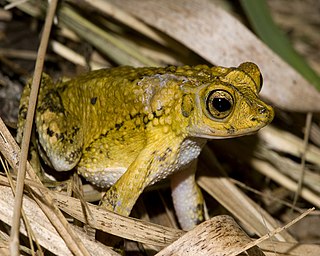
The Puerto Rican crested toad, or simply Puerto Rican toad, is a species of toad found only in Puerto Rico and the Virgin Islands. It is the only species of toad native to Puerto Rico and the Virgin Islands. The species formerly occurred in Virgin Gorda and along the southern and northern karst in Puerto Rico. It is listed as a threatened by the US Fish and Wildlife Service due to habitat loss and introduced species. At one period of time it was believed to be extinct until it was rediscovered in 1966. The IUCN has the species listed as endangered.
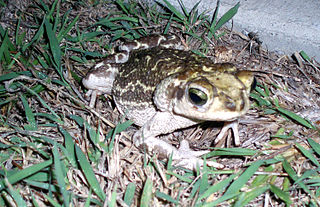
The Cuban small-eared toad, also known as the Cuban toad or Cope's Caribbean toad, is a species of toad in the family Bufonidae that is endemic to Cuba including Isla de Juventud.

The western giant toad is a species of toad in the family Bufonidae that is endemic to western Cuba. It occurs in a range of habitats including broadleaf forest, grassland, savanna, and agricultural areas. It is a common species but it can be locally threatened by habitat loss.
Poyntonophrynus grandisonae is a species of toad in the family Bufonidae. It is endemic to Namibe Province, Angola. Its range may be more widespread than currently known, including the nearby Iona National Park. It is only known from a few specimens because there has not been much research in the surrounding area, and thus its 2014 IUCN Red List of Threatened Species assessment remained at "Data Deficient".
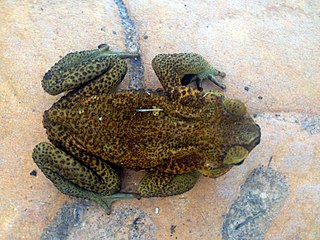
Peltophryne guentheri, the southern crested toad or Gunther's Caribbean toad, is a species of toad in the family Bufonidae. It is endemic to Hispaniola and found in the lowlands of Haiti and the Dominican Republic.
The Cuban high-crested toad, or Gundlach's Caribbean toad, is a species of toad in the family Bufonidae that is endemic to Cuba.
The Cuban long-nosed toad, or Stejneger's Caribbean toad, is a species of toad in the family Bufonidae. It is endemic to Cuba and only known from three widely separated populations. Its natural habitats are upland pinewoods and mesic broadleaf forests. It is always found by streams. It is threatened by habitat loss caused by logging, charcoaling, fires, and agricultural expansion.
Mertensophryne lonnbergi is a species of toad in the family Bufonidae. It is endemic to Kenya and known from the highlands on both sides of the Great Rift Valley as well as from Mount Kenya. Its natural habitats are montane grasslands, moorlands, and forest patches; it can survive also on agricultural land. Breeding takes place in small and shallow permanent or semi-permanent pools. It is a reasonably common species, but habitat modification could still be a threat.
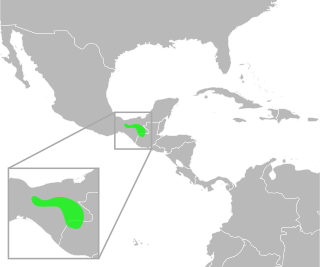
Incilius macrocristatus a species of toad in the family Bufonidae. It is found in Chiapas in southern Mexico and the adjacent Guatemala. Its natural habitats are cloud forests and pine-oak-Liquidambar forests. Breeding takes place in streams. It is a rare species that is threatened by habitat loss caused by agriculture and human settlement, and by water pollution.
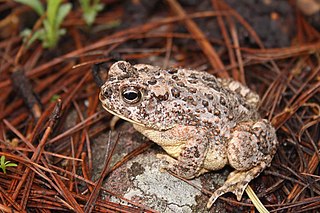
The southwestern toad or Mexican Madre toad, formerly Bufo mexicanus, is a species of toad in the family Bufonidae. It is endemic to north-western Mexico and found on the Sierra Madre Occidental in eastern Sonora and western Chihuahua and south to south-western Durango. Its natural habitats are conifer forests, commonly along low rivers and streams, its breeding habitat. It is a rare species threatened by habitat disturbance, including alterations causing the desiccation of streams and soils.

The western leopard toad is a species of toad in the family Bufonidae. The species is endemic to the low-lying areas of the Cape Peninsula, the Cape Flats and the Agulhas flats of the Western Cape, South Africa.

Peltophryne peltocephala is a species of toad in the family Bufonidae. It is endemic to Cuba and found in central and eastern Cuba as well as on some outlying islands. It occurs in a range of habitats including broadleaf forest, grassland, savanna, and agricultural areas. It is a common species but locally threatened by habitat loss.
Rhinella rubropunctata is a species of toad in the family Bufonidae that is found in southern Chile and Argentina. Its natural habitats are humid to xeric temperate forests and open environments. It tolerates a certain degree of disturbance. Breeding takes place in shallow temporary ponds near rivers, reservoirs and lakes. It is threatened by habitat degradation and fragmentation.

Duttaphrynus scaber is a species of toad in the family Bufonidae. It is found in peninsular India and Sri Lanka. Bufo fergusonii, now synonymized with Duttaphrynus scaber, was named after Harold S. Ferguson who collected the type specimen.

The Cuban spotted toad, or Cuban Caribbean toad, is a species of toad in the family Bufonidae. It is endemic to central and eastern Cuba. Its natural habitats are lowland mesic broadleaf forests, but it also occurs on cultivated fields as long as they are not too intensively farmed. It is common in suitable habitat but its distribution is severely fragmented and its habitat is threatened by intensive agriculture, charcoaling, and nickel mining.

Incilius tutelarius is a species of toad in the family Bufonidae. It is found in the Sierra Chimalapa and Sierra Madre de Chiapas in Guatemala and Chiapas, Mexico. Its natural habitats are cloud forests and pine-oak (broadleaf) forests. It is closely associated with streams, its breeding habitat. It is threatened by habitat loss.

Peltophryne is a genus of true toads in the family Bufonidae, from the Greater Antilles. With ten endemic species, Cuba hosts the highest diversity. Hispaniola has three endemics and Puerto Rico and the Virgin Islands combined have one.












